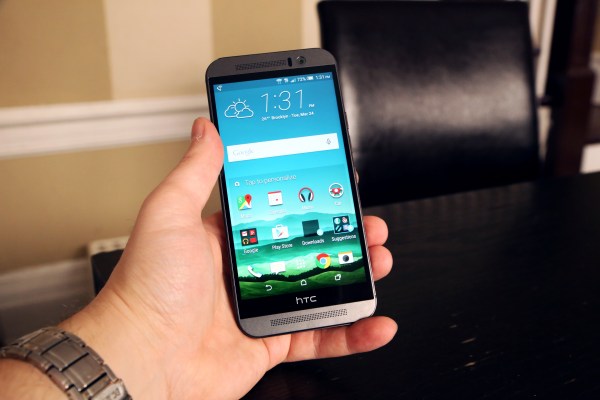Repetition, it’s been said, is a sign of persistence and dedication. It’s also a sign of insanity. That’s where HTC is right now and, while it would be a fine place to be if there was no strong competition in the smartphone market (just ask Samsung), it’s not a great position for a company facing Xiaomi and other smartphone players on the prowl.
And repetition is what you get when you pick up the HTC One M9. It’s an iterative improvement on the M8, very handsome and well-built. It’s not extremely expensive — $649 unlocked and about $199 on most carriers with contract — but it’s not the cheapest phone out there. In short, it’s a middle-of-the-road model facing some real competition. The 20-megapixel main camera is slightly better than the predecessor but still nothing particularly special. Gesture features like a “tap to wake” and “turn to activate camera” make the thing a bit easier to use.
Battery life was about 11 hours. It remained powered and on standby for a full day and a half, much to my surprise. Call quality and network were fine in New York and New Orleans. The camera, as we can see below, takes great macro shots as well as acceptable selfies and wide shots. The shooting modes – including many face improvement features (which I need) – are an added bonus.
[gallery ids="1138481,1138482,1138483,1138484,1138485,1138486"]
If you’re an HTC fan you will find this model to be materially superior. First the metal finish has been improved to reduce slippage and the camera has been improved somewhat. It runs a Snapdragon 810 processor with 3GB RAM and is snappier and simply better than last year’s “best new Android smartphone.” I am consistently impressed with this series and the effort HTC put into creating a clever galaxy of accessories as well as their effort to streamline and improve stock Android.
But if you’re a non-HTC fan it might be hard to recommend this phone over others. Sure it has a beautiful case made of brushed aluminum. Sure it has a bright screen, a stately Sense UI, and enough power to take on most Android comers. But it’s also a nearly exact clone of the M8 and, when compared to the arguably superior Samsung Galaxy S6 Edge and the iPhone 6, is still bulky and can be perceived as an incremental improvement over a phone that may or may not have caught your attention last year.
Therein lies the rub: do you invest in a larger, solid phone with a clean user experience or do you remain with your current manufacturer be it Samsung, Apple, or anyone else. Like Motorola before it, HTC is hoping that familiarity will reduce contempt. In a war between the S6 and the M9, for example, that familiarity could damage HTC’s chances.
I still like this series of phones and during the time I spent with it I found it fun, creative, and usable. I wouldn’t buy it over the Galaxy S6 Edge or trade in an iPhone for it but that’s me — you may have different reasons to own an aluminum smartphone with nice internal speakers and excellent styling — and I feel that when comparing this against other mid-level phone the HTC wins it.
But this seems like a phone hatched in a vacuum. While most other manufacturers typically will drop in a few differences, HTC has quite simply upgraded the innards and pushed a new phone out the door. That’s just fine, there are many who don’t want curved screens or new designs and the M8/M9 “water-worn pebble” aesthetic is extremely beguiling. That said, I worry that this is a me-too product in a year full of look-at-us ones.
In the end the One M9 is a solid phone from a solid manufacturer. If that’s enough to get a few hundred thousand units off the shelves and into pockets then I’m sure HTC will be happy – and I think you’d be happy if you felt this aluminum-clad beauty weighing down your front pocket.
[gallery ids="1136823,1136821,1136819,1136818,1136816,1136815,1136814,1125611"]
